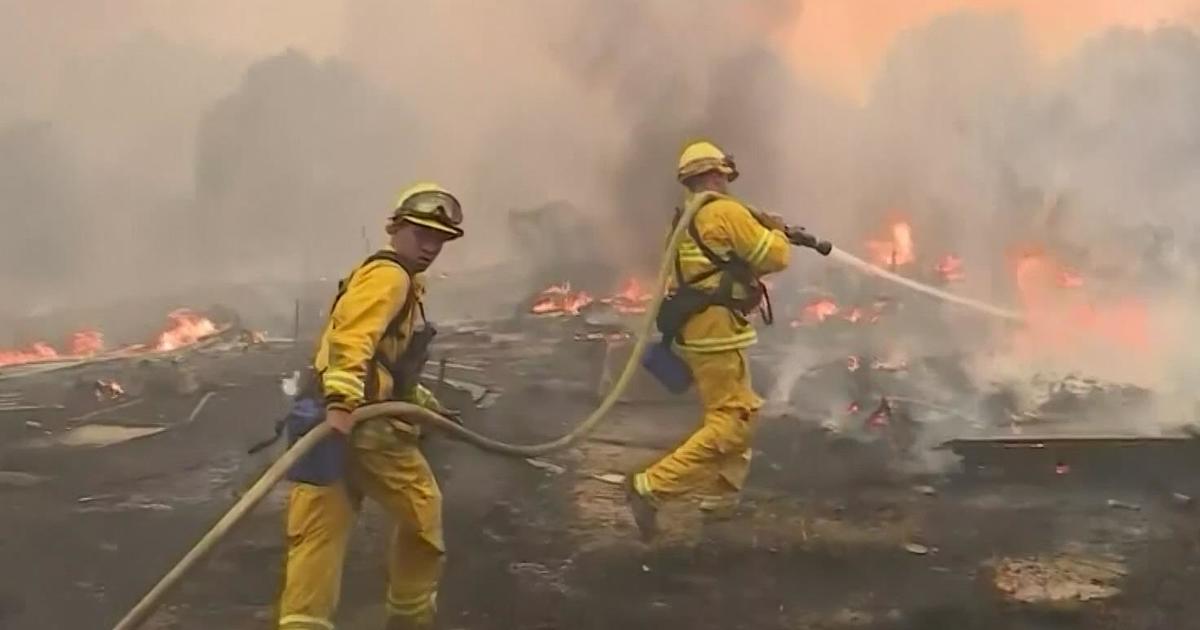AP Exclusive: Wildfire Citations Applied Unevenly
SACRAMENTO (AP) - Gary Bennett spent much of the last three decades preparing his property in Napa County for the day when a wildfire would sweep over the hill, including clearing brush and grass around his three-bedroom home in a scenic canyon 85 miles north of San Francisco.
That paid off when the 4,300-acre Butts Canyon fire roared through his property July 1, sounding like "five jet airplanes landing in my yard," Bennett said. His home was spared while a neighbor's cabin that had been surrounded by overhanging oak trees was destroyed.
If they lived elsewhere in California, the neighbors might have received stern warnings from local authorities, including fines and citations requiring them to clear their properties. A review by The Associated Press of state data revealed wide geographic discrepancies in how state and local fire officials apply fines and citations for failing to clear vegetation in areas prone to wildland blazes.
Property owners in southern and central California were cited 5,076 times during the past three fiscal years for not doing enough to clear their properties and protect their homes from wildfires. During the same period, just eight such citations were issued in all of Northern California, and all of those came in a single year in Tehama and Glenn counties.
The divide is not simply a north-south one. There are great differences even within what state fire officials consider their southern region. Los Angeles County accounts for the bulk of the citations, while Orange and San Diego counties had just one between them even though both have been subject to destructive wildfires in the past decade.
The discrepancy in citations and compliance with brush-clearing is potentially important as the drought-stricken state enters the heart of its wildfire season. Lower compliance with the state's defensible-space mandate could mean more homes lost when wildfire breaks out.
The California Department of Forestry and Fire Protection data also show residents in the northern part of the state were nearly twice as likely to ignore state and local fire-prevention laws. Inspectors found 18.2 percent of property owners failed to comply with the standards, compared with 9.7 percent to the south.
"The nearly double non-compliance absolutely has to do with less citations," said Janet Upton, a spokeswoman for the department, known as CalFire.
The state mandates a 100-foot "defensible space" perimeter around buildings in fire-prone areas. Citations are considered infractions but elevate to misdemeanors with a minimum $500 fine for a third violation within five years.
The AP reviewed the citations issued by the state and local fire agencies since the state's contentious wildfire-prevention fee was first assessed in 2012.
The $152-a-year fee is imposed on roughly 700,000 properties that are protected by state wildland firefighters, with proceeds going toward programs that enhance fire-prevention, such as brush-clearing and tree-trimming. Inspections are expected to increase throughout the state this year, after CalFire hired more than 50 seasonal inspectors using proceeds from the fee.
For the purposes of its internal record-keeping, the department considers the state's north-south dividing point at Sacramento, on a diagonal line that runs from south of Santa Cruz to Lake Tahoe. That puts the Central Coast and central Sierra Nevada into CalFire's southern region, an area that covers two-thirds of the state's land mass.
Fire officials offer a variety of reasons they say contribute to the dramatic difference in enforcement:
- Southern California is more densely populated and has more structures in rural areas, and many of the citations were in Los Angeles County, which has had a robust enforcement program for years.
- Several of those counties provide fire protection for their residents under contracts with the state and may have more inspectors than the state agency. Five of the state's six contract counties (Kern, Los Angeles, Orange, Santa Barbara and Ventura) are in Southern California, while only Marin County is paid by the state to provide fire protection in the northern half of the state.
- Some of the larger Southern California counties have more resources to prosecute citations than some of the rural Northern California counties, which must prioritize in selecting which cases to pursue.
On his Napa County property, Bennett cleared brush and grass, built rocky terraces and planted drought- and fire-resistant plants around his home. His neighbors not only allowed trees to overhang their home, but they also surrounded it with a wooden deck.
His house survived the Butts Canyon fire, but his neighbor's house was one of two homes the blaze destroyed. A cement slab and chimney were all that remained.
"It turns out most of the preparations I put in place, with the help of some friends, worked," Bennett said. "So now we're just a little island in a black desert."
One reason for the geographic discrepancy appears to be a philosophical divide that has led inspectors to take a more lenient approach in the north.
Rural property owners in many northern counties prefer a more hands-off approach by government, while Southern California residents are fed constant reminders about the importance of clearing brush in a region that is swept each year by hot, dry Santa Ana winds.
In some rural northern counties, the fire-prevention fee and the state's enforcement effort have caused friction and resentment. That includes Plumas County in the Sierra Nevada, 135 miles northeast of Sacramento, where District Attorney David Hollister is requiring that his office approve any citation.
"When CalFire rolled out this program without any meetings to soften the blow and indicated there would be surprise inspections on people's property and citations, that didn't go over too well," Hollister said. "It came out more as an enforcement than an education program. ... Since that rollout several months ago, CalFire has softened their approach."
The department has yet to send him a single citation to prosecute.
During the last three fiscal years, inspectors in the southern region conducted about 396,000 defensible-space inspections compared with about 63,000 in the north. They found more than 29,000 violations, compared with nearly 11,000 in the north, and they wrote 5,076 citations, compared with the handful written in the north.
"Ultimately, the biggest penalty for somebody who refuses to comply is for their house to burn down," said CalFire's Upton. "We don't wish that on anybody."
Copyright 2014 The Associated Press.






